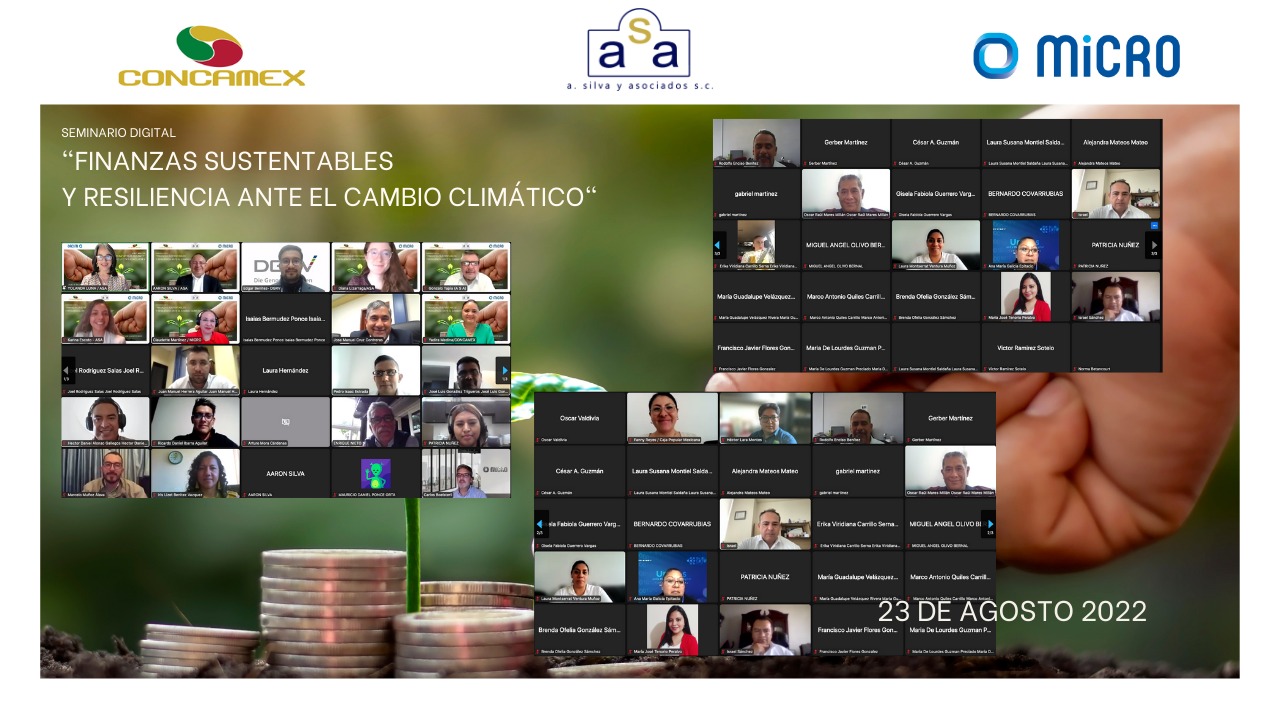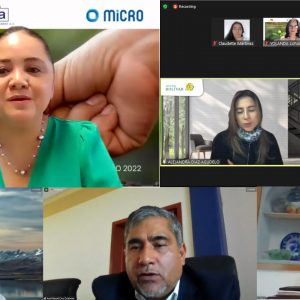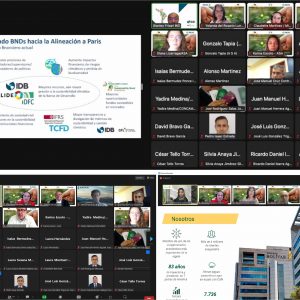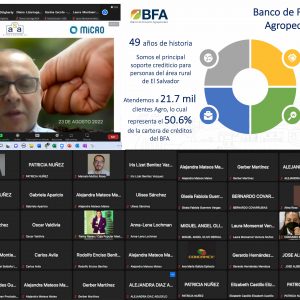
«We need to continue advancing in the implementation of sustainable finance for the cooperative sector in Mexico and measure the impact generated by the placement of green loans. This is more than a regulatory issue, it is a social responsibility that we have as a cooperative guild for the benefit of our members and their families and the environment.» – Yadira Medina Gil, General Director of CONCAMEX
On Tuesday, August 23rd, the Digital Seminar on Sustainable Finance and Resilience to Climate Change, organized by the Confederation of Savings and Loan Cooperatives of Mexico (CONCAMEX), the Microinsurance Catastrophe Risk Organization (MiCRO) and Aarón Silva y Asociados, S.C., was held for the Mexican savings and credit cooperative sector, with the participation of national and international experts from organizations, entities and institutions working on different fronts and levels to strengthen the resilience of vulnerable populations.
SUMMARY OF THE SEMINAR
Giovanni Leo Frisari, Senior Climate Change Economist of the Inter-American Development Bank (IDB) presented the topic Greening development banks and opportunities in sustainable finance where he shared an overview of what the IDB is doing in this area. During his participation he commented that greening comes as a joint action between the financial institutions themselves and the institutions that regulate and that can support the entire sector and the economy as a whole in the transition to a low carbon and climate change resilient development. This greening is important given the pressures and dynamics at the global and regional level that point the way for financial institutions:
- Ever increasing pressure from regulators, supervisors, policy makers at the international and regional level, as well as NETWORKS established by ASBA and the IDB and forums, stressing that there are many regulators in the region that are joining in and in Mexico additional to Banxico is CONSAR and the CNBV working on supervisory and regulatory measures for the sustainable finance sector.
- An ever-growing pressure from the impacts of climate change on financial institutions is materializing in many physical risks, which are impacts related to extreme events or chronic continuous changes in the environment (e.g. hurricanes, droughts) and also with the loss of biodiversity.
- A greater opportunity for sustainable funding in the market for companies issuing green bonds or instruments, with a growing market that can be captured, which comes with a greater measure of transparency with accompanying issuance frameworks and reporting models with specific indicators.
- The interest of civil society and investors in the sustainability of financial institutions.
The specialist also commented on the commitment of international cooperation to support all these issues with various instruments and tools, as part of its institutional commitments and vision. In this regard, he emphasized the sustainable investment opportunity for LAC in the energy, buildings, water and transportation sectors, among others, with a potential of more than one trillion dollars in investment and the generation of more than 27 million new jobs.
He presented the roadmap for institutional alignment to Paris, which they have designed for their counterparts that begins with a green and climate self-diagnosis, then the review of portfolio management and creation of opportunities, as well as ways to manage climate and environmental risks, once the risks are identified, metrics are created and finally a sustainable financing strategy is seen. Finally, the IDB support tools and a couple of examples of these instruments.
Aarón Silva, Managing Director of Aarón Silva y Asociados, S.C. moderated the Panel on opportunities from the point of view of funding, guarantees and new tools, with the participation of:
-
Ángel O’Dogherty Madrazo, Deputy General Director of Sectoral Intelligence at Fideicomisos Instituidos en Relación con la Agricultura (FIRA), who highlighted the great challenges derived from climate change in the activities of the agricultural sector, which is observed throughout the country. FIRA’s main challenge is to mitigate the physical and transition risks of its loan portfolio. He recalled that FIRA operates on the second floor. In the agricultural sector, financial inclusion and risk perception is greater, which also represents an opportunity, since agriculture is affected by the environment, but at the same time, it has adverse effects on the environment. There is sufficient scientific evidence on the effects of climate change, the effects of which could be catastrophic for society as a whole, so there is an obligation to contribute to mitigating this phenomenon.
He recommended as best practices for local intermediaries, in order to face these challenges and opportunities, to consider 3 practices: i) promote green projects, adaptation and mitigation to climate change, the risks of the borrower are also risks for the intermediary, so it is advisable to develop a taxonomy of what is a green project and differentiate it from what is not; ii) Make its risks transparent, i.e., make them public, so that all stakeholders, for example, regulators, can take actions to contribute to their mitigation; and iii) Develop parametric tools to assess the environmental impact of the projects financed by the financial institution, relevant for projects of relatively low amounts, to make them viable from the cost point of view. For example, 90% of the credits supported by FIRA are for small producers, it is not cost-effective or practical to make a direct supervision, so the development of parametric tools facilitates this task, they have a credit risk calculator of the portfolio under different scenarios, the main risks derive from droughts resulting from water stress and heat waves that will reduce crop yields.
-
José Manuel Cruz Contreras, President of the Confederación de Cooperativas de Ahorro y Préstamo de México (CONCAMEX), commented on the actions being taken by cooperatives to address these risks, recalling that cooperatives have been working on the Cooperative Green Pact since 2008. For many small cooperatives that serve small producers it is more challenging to raise awareness among their members to adopt sustainable practices, how they approach it, through the Concamex supports cooperatives to make periodic self-evaluations. They also collaborate with the German Confederation of A and P Cooperatives in two important projects: i) measuring the cooperative social balance sheet and ii) How to work on sustainable finances. They provide environmental education to members and develop rules of conduct to care for the environment. It is important to transmit in a practical and simple way the benefits of adopting water technologies and using renewable energy to members, so that they are clear about the benefits in terms of cost savings for adopting these practices.
On the other hand, CONCAMEX as an organization that integrates cooperatives represents the entire cooperative movement that includes up to 10 million savers, which may not represent an important part of the resources that are mobilized in the financial sector (less than 2%), but approximately 8% of the population, so they should seek alliances with insurance funds, protection mechanisms, prevention activities, and even remediation. They have worked with FIRA to make technological packages accessible to small producers and make them economically viable, which must run in parallel with the generation of environmental awareness, the adoption of more efficient and environmentally friendly technology, as well as alliances that support resilience, to the benefit of the members.
-
Alonso Martínez, National Coordinator of the Biodiversity Finance Initiative (BIOFIN) of the United Nations Development Programme (UNDP), pointed out that we must not lose sight of the loss of biodiversity, which is closely linked to climate change. BIOFIN seeks solutions to address this problem in very important sectors for the economy and society, such as agriculture, infrastructure, tourism, and ecotourism, since the latter, for example, are based on natural and cultural values that are highly affected by climate change. Strong impacts have been observed in these activities and these can be exacerbated, for example, the loss of genetic diversity in food can have a very high cost.
Regarding best practices, he recommended developing a portfolio of “bankable” or bankable green projects, in addition to adopting dissemination initiatives, but translating technical indicators into information that can be integrated by the financial sector in its methodologies, creating financial products in line with sustainable projects because they have particular characteristics in terms of terms of deadlines, returns, etc. In addition, it is complicated to credit individual producers because of the atomized nature of land ownership, but it would be easier to do so in groups with similar characteristics. It is advisable to seek hybrid financing, combining different sources of financing and support with guarantees, technical assistance, etc.
Claudette Martínez, MiCRO’s Growth Manager, moderated the Panel of international experiences where two experiences in the region and a video testimonial of policyholders in Guatemala were presented.
-
Alejandra Díaz, Sustainability Director of Seguros Bolívar, the third largest insurance company in Colombia, presented the Campo Seguro experience, which seeks to strengthen the adaptation to climate change of small producers in the agricultural sector of one of the largest microfinance institutions in the country. Alejandra began by contextualizing this solution within the sustainable business strategy, in which the insurer is committed to strengthening the resilience of individuals and companies to various risks, with special emphasis on those arising from climate change, which is accompanied by closing the protection gap, which is why they have proposed to have inclusive insurance solutions and services, as well as green and climate insurance solutions for historically underserved populations, highlighting that this cannot be done alone but through partnerships.
One of these allies, Fundación de la Mujer, is a 178k MFI with a presence throughout the country, with 23% of its portfolio in rural areas and with experience in promoting a culture of insurance among its clients in other lines of business. It was decided to present Campo Seguro, which seeks to cover producers with a parametric insurance in case of excess rainfall and rainfall deficit, together with a light insurance to cover damage to housing caused by landslides and others. The parametric component allows extending the frontier of insurability, with a cost-effective solution and recognizing that in the event of an event the producer’s income will be affected or his expenses increased. Built without deductibles, without deductions and without the need for claims, without individual adjustment in the field. The more severe the event, the higher the payment. In the case of the damage component, it has the particularity of applying a voice stress method to validate the credibility of the client’s claim in order to expedite payments.
In six months of operation, there are 3,156 policyholders and 2.3 million dollars of protected productive assets, as well as a series of lessons learned about the dilemma of the cost of insurance and the value delivered to the client, the payment dispersion mechanism, and the importance of fine-tuning the product.
-
Gerber Martinez, Manager of the commercial division of Banco de Fomento Agropecuario, which is the main credit support for people in rural areas of El Salvador, serving 21,700 Agro clients nationwide (50.6% of the credit portfolio), financing more than 635 thousand manzanas for crops. Gerber presented the experience of Produce Seguro, which is a parametric insurance product they have as a tool against climate change, designed to address the periodic decapitalization that their clients may suffer in the event of damage caused by natural disasters. The product protects against the commercial interruption of the client’s productive activity in the event of drought, excess rainfall and earthquakes, operating based on automatic measurements of weather change measurement indicators.
Since its launch in 2018, 28,043 clients have been insured with productive credits accompanying them with education days on risk prevention and mitigation oriented to policyholders. The most recent event occurred in 2020 with the impact of storm Amanda, where 88% of the policyholders of that year benefited from the insurance.
Finally, Gerber indicated that one of the main lessons learned is that with this product the Bank offers the possibility of limiting the financial impact of the devastating effects of natural phenomena. As a leading bank, it provided the necessary inputs for the regulatory framework so that it can be replicated by other banks or finance companies. For the first time, the market is experiencing parametric insurance.
After the presentation of these experiences, a video was shown with the experience of two microenterprise clients and a coffee producer client in Guatemala, who acquired a loan accompanied by catastrophic insurance against natural disasters such as excess rainfall, which has provided them with peace of mind and protection in the event of a natural disaster.
Finally, both panelists recommended that institutions that decide to design this type of tool should know very well the segments they are going to serve, such as the agricultural sector, and design products adapted to their needs, while ensuring that they have adequate processes and mechanisms to reach the end client, considering their context and that they can provide an agile response in the event of a climatic event so that the producer can quickly continue his productive activity.
The last speaker of the seminar, Edgar Benítez, Project Consultant at the DGRV of Ecuador, in the area of Sustainable Finance and Green Finance, presented part of the context of the sustainable strategy of the DGRV, the pillars of work and the tools they have for the cooperative sector, among these: the awareness and sustainable finance course, the tool for the environmental and social risk analysis system for cooperatives and the green MicroScore tool aimed at supporting the risk analysis of cooperatives’ operations.
The seminar was closed by Yadira Medina Gil, General Director of the Confederation of Savings and Loan Cooperatives (CONCAMEX), who highlighted the importance of sustainable finance for the cooperative sector in Mexico, which is already being worked on. Yadira pointed out that it is necessary to continue advancing in its implementation and to measure the impact generated by the placement of green loans. Yadira emphasized that this is more than a regulatory issue, it is a social responsibility that we have as a cooperative guild for the benefit of the members and their families and the environment, and she invited the cooperative sector to continue working together with national and international organizations and experts.
Back to all posts

